Patents
Freeze-Dried Human Bodies
Philip Backman's 1978 patent describes a process for freeze-drying human bodies.The problem with freeze-drying any large animal is that there's not enough surface area to allow for rapid freeze-drying. So, to increase the surface area, Backman explained that it would first be necessary to freeze the body and then smash it into small pieces in a hammer mill. Once the body had undergone this "surface enhancement," it could be rapidly freeze-dried, which would remove the water in the body, reducing its weight by 95%. The resulting remains could be kept in an urn, just like cremated remains.
Backman argued that his freeze-drying process had all the advantages of cremation (in terms of reducing the body to a compact size), but cost less. However, the funeral industry apparently didn't like the idea of running bodies through a hammer mill.


Posted By: Alex - Sun May 31, 2020 -
Comments (6)
Category: Death, Inventions, Patents, 1970s
Buried at the golf course
In 1989, a Canadian company tried to promote the idea of burying people at golf courses. They imagined that courses could add memorial walls made out of their patented "mod-urns" — hollow, cremain-filled building blocks that could be snapped together to make instant memorial walls.A company rep argued that this could be "a potentially lucrative business for golf courses, who could pack in up to 50,000 new 'members' per acre."


Ottawa Citizen - Sep 29, 1989
Posted By: Alex - Mon May 25, 2020 -
Comments (0)
Category: Death, Sports, Golf, Patents, 1980s
Tuberosity Meter
In 1960, Thomas Scoville received a patent for a device for measuring tuberosity. He explained that the purpose of measuring tuberosity was to improve the fit of chairs:
Even after looking up the meaning of the word 'tuberosity' in the dictionary, it took me a while to figure out what exactly Scoville's device was measuring, and what it possibly had to do with chairs. Because the dictionary simply defined tuberosity as a 'rounded swelling.' Some more googling revealed that Scoville must have been referring to the Ischial tuberosity, or 'sitting bone'. As defined by wikipedia, this is:
Posted By: Alex - Sun May 24, 2020 -
Comments (1)
Category: Body, Furniture, Inventions, Patents, 1960s
Frederick Newbery’s long-distance milk pipes
Frederick Newbery envisioned pipes transporting milk underground from farms directly into cities. He received a patent for this idea in 1874 (No. 148,620). Though as far as I know, his long-distance milk pipes were never put into practice.
Posted By: Alex - Sun May 17, 2020 -
Comments (3)
Category: Inventions, Patents, Nineteenth Century
Exercise Wings
Richard Burgess's 1941 patent (No. 2,244,444) describes a pair of feathered wings that could be attached to the arms of an individual, who would then flap the wings up and down. This, claimed Burgess, would create a sense of buoyancy, while simultaneously providing physical exercise. In particular, it would "develop the chest, back, arm and leg muscles, while also tending to create accelerated breathing and thus general physical tone." It would do all this, he said, while also being "very diverting and accordingly attractive."How did this product never take off?

Posted By: Alex - Sun May 10, 2020 -
Comments (0)
Category: Exercise and Fitness, Inventions, Patents, 1940s
Water-Dispensing Furniture
Thomas Mullenaux of San Pedro, CA was recently granted a patent (No. 10,626,581) for furniture that gathers water from the air via a dehumidifier, collects it in a built-in reservoir, and then allows a person to drink it through a retractable hose.However, in his patent application, Mullenaux never explains why anyone would want or need 'water-dispensing furniture'. I guess it might be useful for those who are too lazy to walk to their kitchen to get a glass of water.


Posted By: Alex - Sun May 03, 2020 -
Comments (2)
Category: Furniture, Inventions, Patents
Informative Swimwear
In 2005, Robert Dickey and Ruth Stephens filed a patent application for "swimwear as information device." Their idea was to make a line of swimwear that displayed maritime signal flags. This would allow people to communicate messages to those around them via their swimwear. They explained:The possible messages one could send seemed limitless, but they were never granted a patent. Perhaps the idea of messages on clothing was deemed too obvious.
There's also the limitation that only people conversant with maritime signal flags could decode the messages, which would make the various 'stay away' messages somewhat pointless.
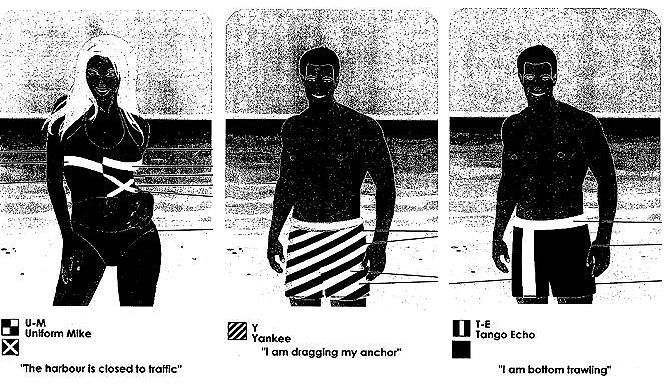
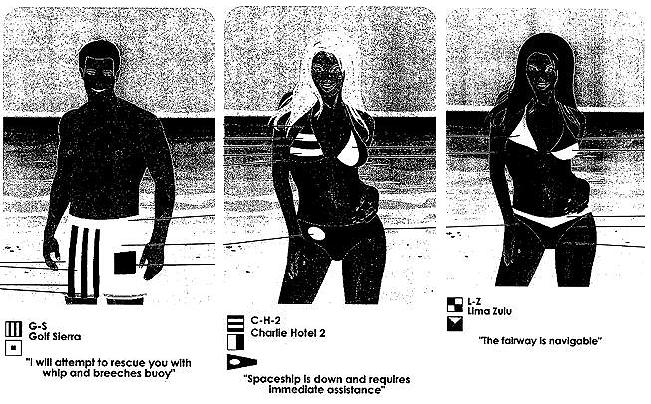
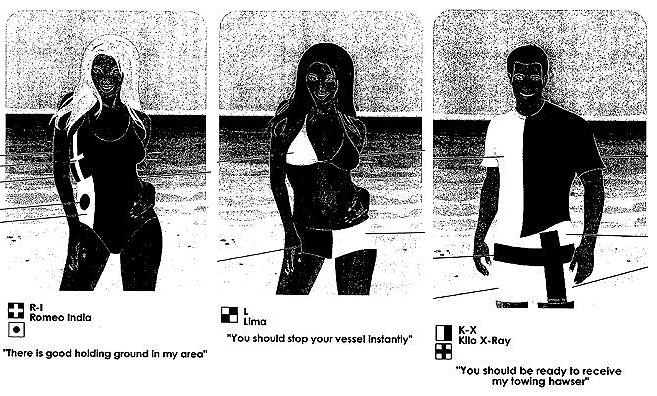
Posted By: Alex - Sun Apr 26, 2020 -
Comments (3)
Category: Boats, Fashion, Inventions, Patents, Languages, Double Entendres and Nudge-Nudge, Wink-Wink
Clean Hands Assured
Claude Davis of Melbourne, Florida obtained a patent for this curious device in 2000. It seems newly relevant in the era of coronavirus.The gadget attached to bathroom doors. Whenever someone turned the handle to open the door, the gadget would spray their hand with dye. This, reasoned Davis, would encourage people to wash their hands, to remove the dye. He imagined his invention might be useful in restaurants and hospitals that have "statutory type hygiene requirements to have their staff and employees clean their hands after using restroom facilities."

Although the invention had good intentions, I can think of several problems with it.
First, I'm sure that most employees would find it incredibly obnoxious to have their hand sprayed with dye every time they went to the bathroom.
Second, wouldn't the gadget also spray dye whenever someone exited the door... spraying into empty air? In which case, half the dye would be wasted. I can imagine employees standing on the inside of the door, pumping away at the door handle until all the dye was used up.
Posted By: Alex - Sun Apr 19, 2020 -
Comments (2)
Category: Bathrooms, Hygiene, Inventions, Patents
Anti-Aging Chair
Hattie Wiener received patents in 1991 and 1993 for an anti-aging chair. The two patents were basically variations on the same theme. The 1991 version of the chair is on the left below, and the 1993 version is on the right.Actually, in the patent write-ups she didn’t mention the anti-aging properties of the chair, but that’s how she described it to the media. She also promoted herself as an “anti-aging consultant.”
The idea was that the chair would force a person to sit upright, and thereby improve their posture and circulation. And this, in turn, would help a person stay healthy as they aged.
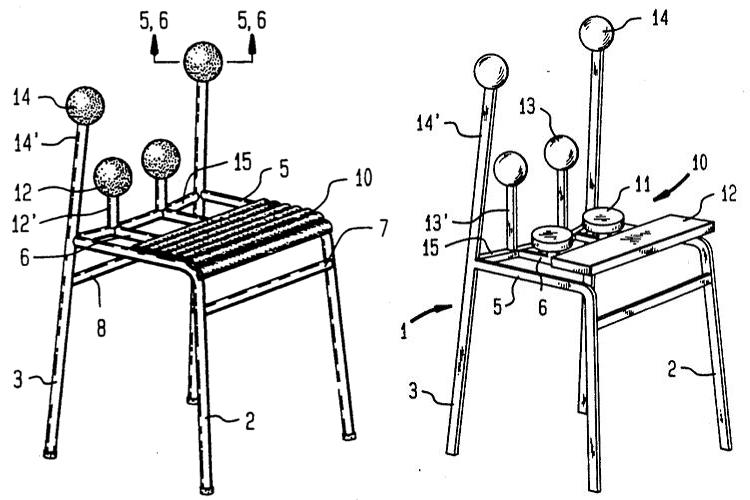
She hoped to sell the chair for $600. A lot for a fairly minimalist piece of furniture. But as far as I can tell, it never made it to market.
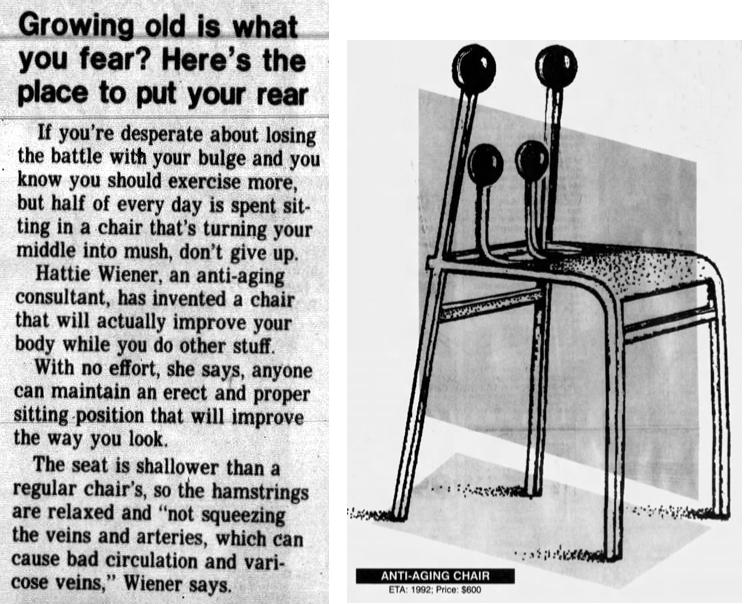
(left) The Desert Sun - Oct 27, 1991; (right) Austin American-Statesman - Nov 10, 1991
Hattie was in her 50s when she patented the chair. Fast-forward almost thirty years, and now, in her 80s, she's still in the news, but for a very different reason. She's become known as the "Tinder Granny," due to her enthusiasm for using the dating app Tinder to find hookups with younger men.
She's certainly defying the stereotypes of age. But I'm disappointed that in none of the recent pictures of her is she using her anti-aging chair. In fact, in the photo below she's totally slouching.
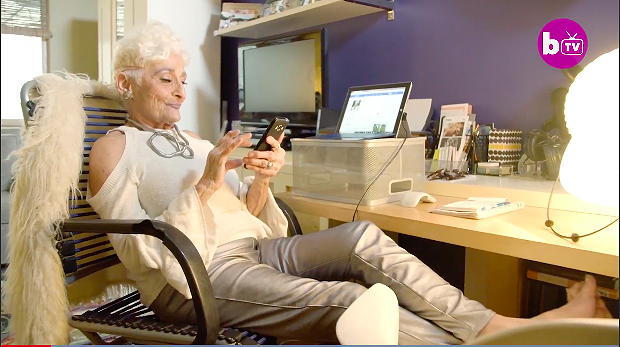
Hattie Wiener, age 83
Posted By: Alex - Sun Apr 12, 2020 -
Comments (2)
Category: Elderly and Seniors, Furniture, Inventions, Patents
Camera Hat
John L. Johnson of Pinehurst, Washington obtained a patent for his "camera support" in 1945. Patent No. 2,369,829. The support provided a way to conceal a camera inside a hat.I wonder if the patent illustration was a self-portrait.

Posted By: Alex - Sun Apr 05, 2020 -
Comments (2)
Category: Inventions, Patents, Photography and Photographers, 1940s

| Who We Are |
|---|
| Alex Boese Alex is the creator and curator of the Museum of Hoaxes. He's also the author of various weird, non-fiction, science-themed books such as Elephants on Acid and Psychedelic Apes. Paul Di Filippo Paul has been paid to put weird ideas into fictional form for over thirty years, in his career as a noted science fiction writer. He has recently begun blogging on many curious topics with three fellow writers at The Inferior 4+1. Contact Us |




